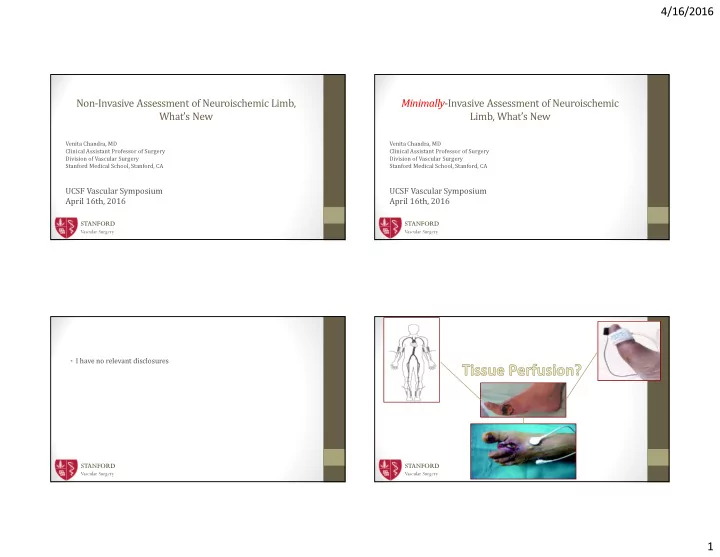

4/16/2016 Non-Invasive Assessment of Neuroischemic Limb, Minimally -Invasive Assessment of Neuroischemic What’s New Limb, What’s New Venita Chandra, MD Venita Chandra, MD Clinical Assistant Professor of Surgery Clinical Assistant Professor of Surgery Division of Vascular Surgery Division of Vascular Surgery Stanford Medical School, Stanford, CA Stanford Medical School, Stanford, CA UCSF Vascular Symposium UCSF Vascular Symposium April 16th, 2016 April 16th, 2016 STANFORD STANFORD Vascular Surgery Vascular Surgery • I have no relevant disclosures STANFORD STANFORD Vascular Surgery Vascular Surgery 1
4/16/2016 What’s new…ish? Indocyanine Green Angiography (ICGA) • Indocyanine Green Angiography (ICGA) • Hyperspectral imaging (HSI) • SPECT/PET • Microoxygen sensors (MOXY) Peak Desai N. JTCS. 132(3): 2006. STANFORD STANFORD Vascular Surgery Vascular Surgery • Significant differences in • Significant differences in ICGA after intervention perfusion rates in patients with perfusion rates in patients with severe or moderate PAOD severe or moderate PAOD Several patients Several patients compared to normal controls. compared to normal controls. without significant without significant • More sensitive that • More sensitive that changes in ABI, changes in ABI, conventional ABI to detect mild conventional ABI to detect mild but changes in but changes in functional impairment functional impairment ICGA values ICGA values STANFORD STANFORD Vascular Surgery Vascular Surgery Colvard et. al. SPY Technology as an Adjunctive Measure for Lower Extremity Perfusion JVS, In Print. 2
4/16/2016 ICGA Hyperspectral Imaging (HSI) • Pros: • Scanning spectroscopy to construct • Quantitative and Qualitative • Cons: a spatial anatomic map for tissue oxygenation using visual light • Contraindicated in liver and data • Map generated by local molecular • Topographic data across the kidney failure • Requires IV access composition of oxyhemoglobin and region of interest • Appears to be able to assess deoxyhemoglobin levels based on • Added time wavelength selection changes in perfusion • Clinical impact unknown STANFORD STANFORD Vascular Surgery Vascular Surgery HSI for PAD • 65 PAD limbs vs. 92 non-PAD limbs • Significant difference in deoxyhemoglobin levels • Significant differences between • HSI shown to identify skin • HSI shown to identify skin monophasic, biphasic and triphasic waveforms microcirculation in the microcirculation in the neuroischemic limb neuroischemic limb • High sensitivity (86%) and • High sensitivity (86%) and specificity (88%) in determining specificity (88%) in determining healing potential healing potential STANFORD STANFORD Vascular Surgery Vascular Surgery Chin et. al. JVS 2011 3
4/16/2016 HSI SPECT/PET • Pros: • Radioisotopes + nuclear imaging + • Noninvasive, • Cons: high-resolution CT scan imaging • Delivers finer assessment of • Vulnerable to same • Can visualize perfusion and process perfusion by evaluation of weaknesses in terms of skin of angiogenesis oxy and deoxyhemoglobin temperature/condition as • Get both functional and structural levels TCO2 and/or SPP information • No well organized/planned prospective studies Hybrid 99mTc-tetrofosmin single photon emission tomography (SPECT)/CT STANFORD STANFORD Stacy MR,ZhouW,SinusasAJ.Radiotracerimagingof peripheral vasculardisease.JNuclMed2013;54:2104–10. Vascular Surgery Vascular Surgery Angiogenesis SPECT/CT • Pros: • Noninvasive • Cons: • Can give a lot if • Expensive • Require trained team of specific/targeted information (i.e infection, nuclear technicians angiogenesis) • Time Increased activity in ischemic limb • Full potential of clinical applications unknown STANFORD STANFORD Vascular Surgery Adah Almutairi et al. PNAS 2009;106:685-690 Vascular Surgery 4
4/16/2016 Microoxygen Sensors (Lumee *) • Injectable, oxygen-sensitive micro sensor (0.5x0.5x0.5mm) • Biocompatible hydrogel + NIR • First in man safety • First in man safety oxygen-sensitive molecule and feasibility study and feasibility study • External light emitting diode in CLI patients in CLI patients undergoing undergoing detector endovascular endovascular • Pulses of light excite microsensor intervention intervention • Statistically • Statistically and sends light signal back significant increase significant increase in O2 concentration in O2 concentration after intervention after intervention STANFORD STANFORD Vascular Surgery Vascular Surgery * Profusa Inc. South San Francisco Microoxygen Sensors Conclusions • Pros • True understanding of tissue perfusion, key in management of • Live understanding of tissue • Cons the neuroischemic limb • Many new and exciting for the assessment of the neuroischemic • Not FDA approved perfusion/oxygenation • Appears to be more reliable • Permanent implant limb • Most need further study to best determine their clinical impact than other methods such as (although well tolerated) TcPo2 and pulse oximetry • Very little clinical evidence • Invasive STANFORD STANFORD Vascular Surgery Vascular Surgery 5
4/16/2016 Thank You! vascular.stanford.edu STANFORD Vascular Surgery 6
Recommend
More recommend